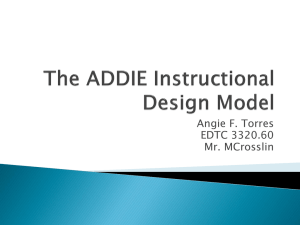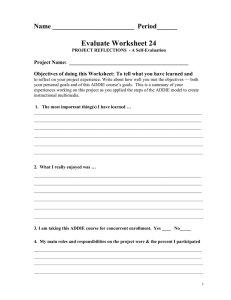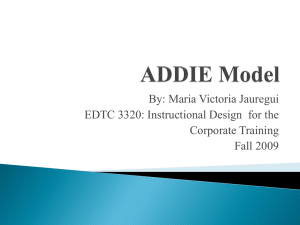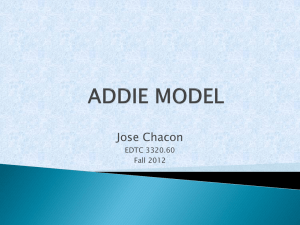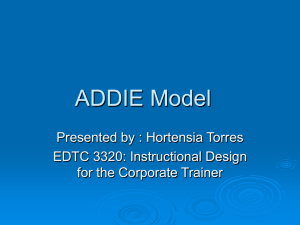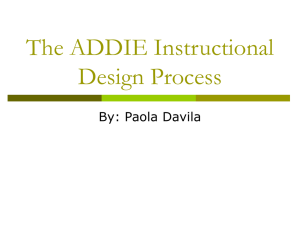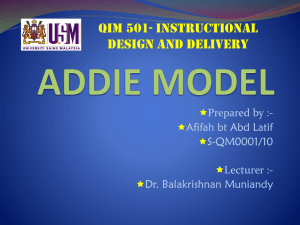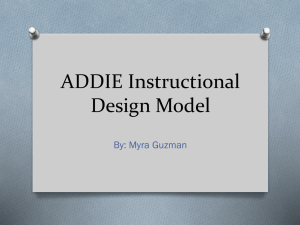ADDIE: The Instructional Design Model
advertisement
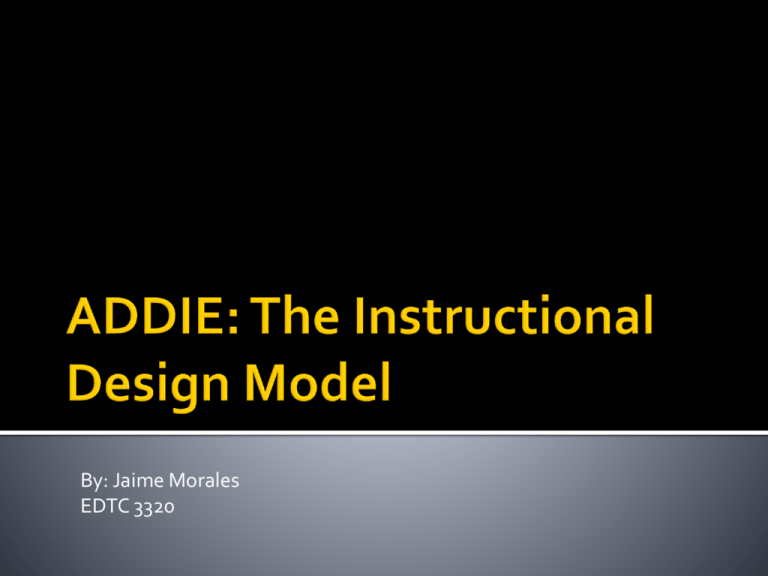
By: Jaime Morales EDTC 3320 ADDIE: A VISUAL GUIDE The 5 phases of the ADDIE Model include: 1. 2. 3. 4. 5. Analysis Design Develop Implement Evaluate www.csuchico.edu “Considering that theory drives practice and practice tests theories (Argyris & Schön, 1974; Reay, 1986), it has become generally accepted that linking both instructional and learning theories to practice is an essential approach to efficacious educational design work (Tennyson, 2010)”. (Excerpt from Ashbaugh, M. 2013) According to Shor (2012) “every workplace learning and performance professional is familiar with ADDIE”. Shor (2012) affirms that ADDIE “ has been the instructional systems design approach of choice for many years and is part of the ASTD competency model, crossing over into multiple areas of expertise, including designing learning, delivering training, human performance improvement (HPI), and measuring and evaluating”. Phase 1 In this phase, there is a careful examination of the learner and the scope that includes background knowledge and competency, learner characteristics, the goal and intent of each learner with expected outcome while considering timelines and budget while not forgetting the affective domain of each learner and their desire, motivation and goal to learn and achieve. Phase 2 This phase considers the content of what will be taught, delivery processes and approaches that include differentiation, interactivity that meets the expectations of building cognitive, psychomotor and affective skills, while simultaneously meeting content objectives within each activity, lesson, module or project. Phase 3 In this phase, the consideration to the variance of learner’s needs is extended a bit further. The aspect of differentiation is broadened so that the view encompasses various formats of delivery, multimedia use, allowing for exploration and creativity and higher success in learning and performance at heightened levels. Phase 4 A plan is only as good as its implementation, therefore there must be a back-up in case something is not functional or challenges are met. A learner has to know how a plan will be carried out from start to finish. They must know firsthand what tools and resources will be available to ensure correct application and implementation. Phase 5 Phase 5 is about assessing whether or not there was success. Success in performance, achievement of standards, certain methodology, in the design, development, and implementation of the project, task, application. This is an observation into what worked, what didn’t and how can it be changed to be more effective. ADDIE Model. Retrieved from: www.csuchico.edu on February 1, 2014. Argyris, C. & Schön, D. (1974). Theory in practice: Increasing professional effectiveness. San Francisco, CA: Jossey-Bass. Ashbaugh, M. (2013). Personal Leadership in Practice: A Critical Approach to Instructional Design Innovation Work. Techtrends: Linking Research & Practice To Improve Learning, 57(5), 74-82. Reay, R. (1986). Bridging the gap: A model for integrating theory and practice. British Journal of Social Work, 16, 65-77. Shor, R. M. (2012). ADDIE +: Adopting Proven Practices From the IT Industry. T+D, 66(5), 56-61. Tennyson, R. D. (2010). Historical reflection on learning theories and instructional design. Contemporary Educational Technology, 2010, 1(1), 1-16. [ELECTRONIC VERSION]. Retrieved on February 7, 2014 from http://cedtech.net/articles/11/111.pdf Wang, S., & Hsu, H. (2009). Using the ADDIE Model to Design Second Life Activities for Online Learners. Techtrends: Linking Research & Practice To Improve Learning, 53(6), 76-81
